在新能源快速发展的时代,为达到国家提出的十四五规划中“碳中和”和“碳达峰”目标,新能源的发展迫在眉睫。核能作为一种高效的清洁能源,因具有燃料消耗少、能值高、经济、安全、不释放温室气体等优点被各国重视[1]。 核能的产生可以通过核衰变、核裂变和核聚变3 种方式进行, 而人类大规模核能的生产主要依赖核裂变和核聚变, 核反应堆内恶劣的运行环境对其中服役材料的性能提出很大挑战。
在裂变堆中, 常用的核金属结构材料包括作为包壳材料的锆合金(Zr-2、Zr-4 等)[2-9]、铝合金、镁合金等, 作为结构材料使用的奥氏体不锈钢[10-11](304、316L 等)、低合金钢、镍基合金[12-15]等。 钨及钨合金[16-20]、钼合金[21-23]、钒合金[24]、低活化铁素体/马氏体钢[25-28](RAFM) 等作为聚变堆的关键结构材料仍在不断的研究当中。 另外,还有很多有潜力的金属结构材料仍在持续开发,例如FeCrAl(FeCr)合金[29-33]、氧化物弥散强化钢(ODSs)[34-35]、高熵合金[36]等。 材料在使用过程中受到裂变或聚变产生的γ 射线、 高能中子、裂变碎片等攻击,造成内部微观结构变化,从而引起材料性能的变化,包括辐照硬化脆化[16,21]、辐照肿胀[37-38]、辐照蠕变[8]、韧脆转变温度(DBTT)升高[39]等,使材料的性能大幅度降低,最终造成事故发生[2]。 与此同时,材料经高能中子辐照发生嬗变反应(n,p)(n,α)生成氢、氦元素,当他们进入材料内部与位移级联产生的缺陷(位错环、空洞)等相互作用,会进一步加剧辐照损伤[37]。 因此研究核金属结构材料在辐照过程中的氢氦行为是极其必要的。
本文围绕核金属结构材料的氢氦行为,系统总结了国内外几种代表性金属结构材料在氢氦影响下缺陷的产生、演化行为及作用机制等方面的研究成果,讨论了不同辐照条件、表面与界面等因素对这些过程的影响,有利于未来新型金属结构材料抗辐照性能的研究。
1 氢氦元素对位错环的影响
1.1 位错环的形成
位错环是一种常见的晶体缺陷,它是位错的特殊存在形式,实际上也是由点缺陷聚集形成。 在材料服役过程中,高能中子辐照产生级联损伤,形成弗兰克尔对,当大量点缺陷聚集形成空隙,空隙的坍塌在二维平面上形成层错,层错环(Faulted dislocation loops) 在特定取向平面上进一步反应就形成了晶体位错环(Perfect dislocation loops)[40]。位错环的类型分为间隙型和空位型,柏氏矢量则取决于具体的材料,如表1 所示。 常见的BCC 材料,例如钨、铁等, 在辐照过程中产生的位错环柏氏矢量为1/2<111>和<100>。 而FCC 结构材料,例如镍基合金,形成1/2<110> 和1/3<111> 位错环[41-42],辐照过程中以2<110>环为主,1/3<111>位错环占比很低[12]。在HCP 材料中,例如锆合金[43],形成1/3<1120>a-棱柱环和1/6<2023> 或者1/2<0001>、<0001> 的c-基面环, 其中c 环一般在损伤量达到3 dpa(displacement per atom: 单位体积中位移原子与原子总数之比,晶格中每个原子平均位移一次时,产生1dpa)以上由基面三角形空位型缺陷坍塌形成,它与锆合金的辐照生长现象具有密切联系[6,44]。
表1 常见核金属结构材料的位错环类型[42]
Tab.1 Dislocation loop types of common nuclear structure materials[42]
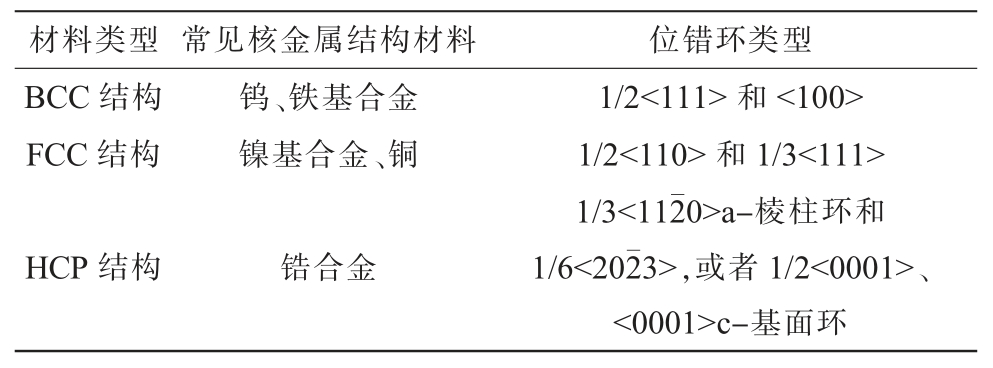
?
不同柏氏矢量的位错环对材料性能影响不同。在Fe 基合金中,1/2<111> 环在晶格中是可滑动的,而<100> 环在500 ℃以下是不可滑动的,只有温度升高至500 ℃才可以滑动[45],因此<100> 环对位错的阻碍作用大于1/2<111>环,对材料的性能影响更大[21]。 大部分BCC 材料中,例如W[17,20,46-48]、Mo[21]及其合金等,辐照过程中都是以1/2<111>环为主,从其形成机制考虑,两种位错环均可以通过Eyre-Bullough机制形成,具体形成过程见式(1)、式(2)[49]:
因为<100> 环的形成能更高[18],无论是层错环反应还是高密度级联碰撞[19],1/2<111> 环都更易形成。 但Fe 及其合金[50]是个例外,它们在辐照过程中更倾向以<100> 环为主,而<100> 间隙环可以有效抑制空腔形成,这可能也是RAFM 钢具有优异的抗肿胀性的原因[18]。 另外,材料成分变化[30]、辐照参数的改变,包括辐照温度[16-17,30,51]、辐照剂量[30,52],辐照粒子种类[17,47-48,51] 等均会改变两者占比。 当引入He时,He 对材料中<100> 环和1/2<111> 环的占比具有明显影响,进而对材料性能产生影响。因为锆合金辐照过程中的氢氦行为研究较少, 更多的是对其内部氢化锆的研究, 所以本文综述了几种具有代表性的金属结构材料中的氢氦行为。
1.2 氢氦元素对位错环柏氏矢量的影响
在W 的辐照性能研究中,Ding 等[16]利用双束的H2+和He+辐照W, 发现随着辐照温度的增加,<100>环的比例提高,从973 K 时的18.6%提升到1 173 K的22.9%。一是因为随着温度的升高,两个1/2<111>环发生合并生成更大的1/2<111>环,造成其数量下降。 二是W 的层错能较高,通过Eyre-Bullough 机制[49]形成<100> 环较难。 在Li 等[18]对W 辐照性能的研究中,1/2<111> 环之间的距离使其无法接触反应生成<100> 环[18],而这种<100> 环产生机制被证明在纯Fe 中是可以通过式a/2 [111]+a/2[111]=a[100][49,53]产生。 三是可能因为高密度氦泡挤压形成,这种机制在分子动力学(Molecular dynamics,MD)计算模拟中也得到了证实[18],如图1 所示。所以当辐照温度升高时,W 中<100> 环比例提高,如图2(a)所示。 他们还在近似的条件下仅改变损伤量大小对W进行辐照,发现改变损伤量对<100> 环比例影响并不大[52]。
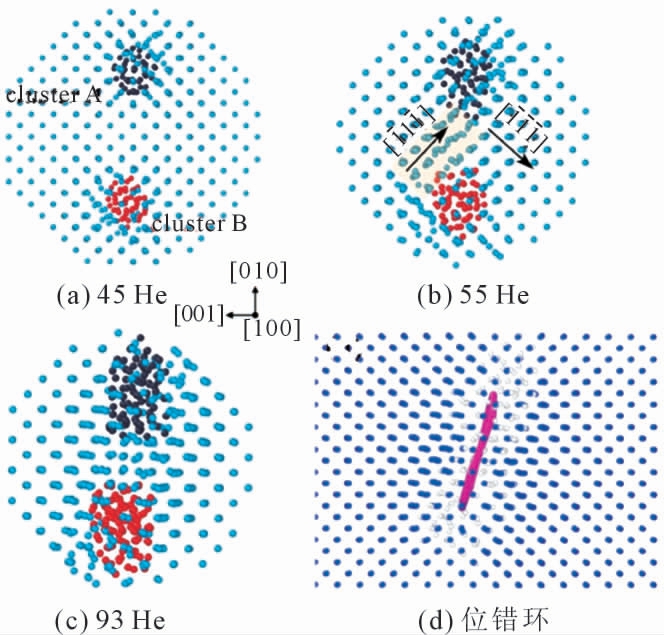
图1 氦泡挤压机制分子动力学(Molecular Dynamics,MD)模拟图[18]
Fig.1 MD(Molecular Dynamics)simulation diagram of helium bubble extrusion mechanism[18]
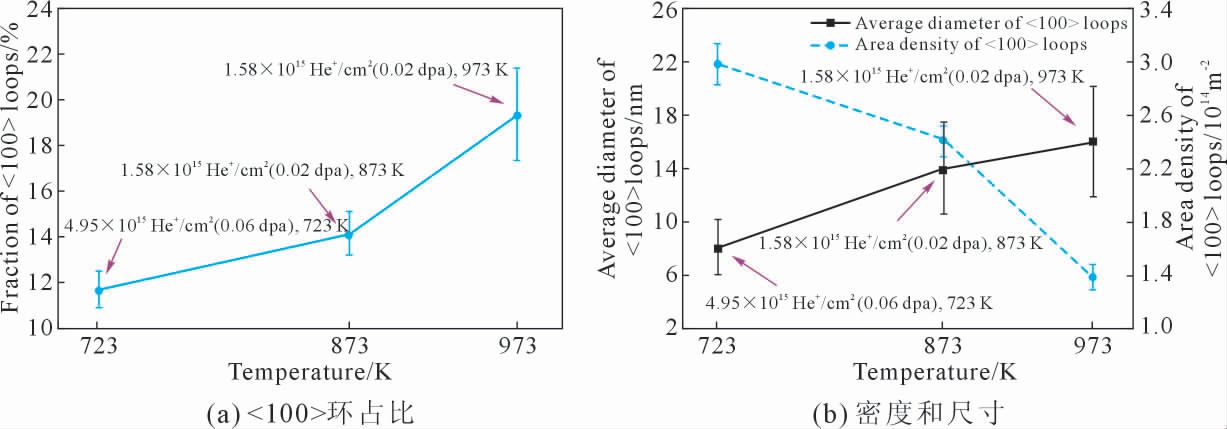
图2 230 keV He+辐照W 中温度对<100>位错环影响[18]
Fig.2 Effect of temperature on<100>dislocation loops in 30 keV He+irradiation W[18]
但Harrison 等[20,47-48]在利用单束He+辐照W 时,即使在相近条件下也没有观察到<100> 环。 在Zheng 等[19]研究中同样发现,单束He+辐照与单束重离子辐照后相比,<100> 环比例并没有提高,如图3(a)所示。 经研究发现重离子可以产生高密度位移级联,为<100>环形成提供更多机会。 除此之外,还可能与所使用的材料纯度、实验条件以及<100> 环可以反应生成1/2<111>环等原因相关[52]。 在研究Mo中位错环比例时,发现了与W 中位错环相同的变化规律[21]。 同样地,Chen 等[12]研究Ni 基合金中的氢氦行为时也发现,在He 团簇的作用下,1/2<110> 间隙环占比大幅度增加, 其机理和<100> 环比例提高相同。
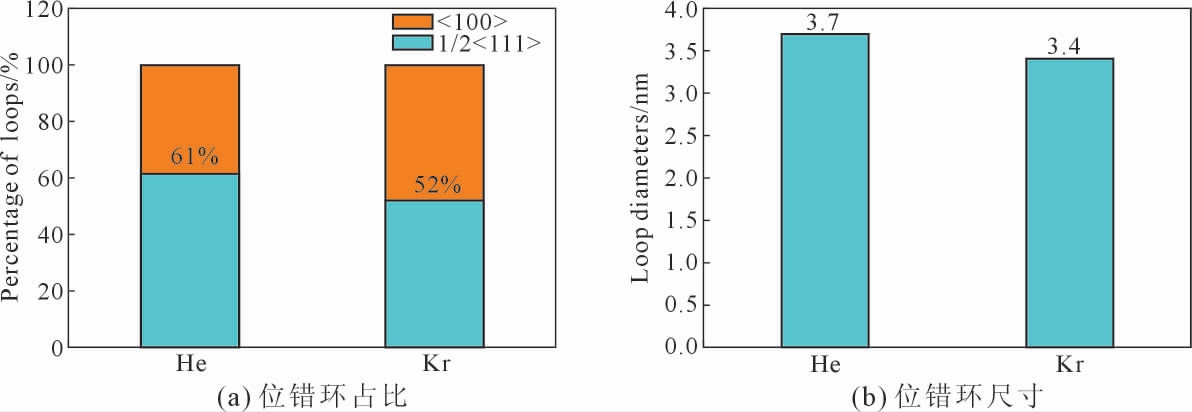
图3 重离子与He+辐照对W 中<100>和1/2<111>位错环的影响[19]
Fig.3 Effect of heavy ions and He+irradiationon<100>and 1/2<111>dislocation loops of W[19]
在对Fe 及其合金的辐照性能研究中,Prokhodtseva 等[31]指出,在室温下,利用500 keV Fe+ 辐照纯Fe 时,<100> 环的比例达到89%,其中一部分通过重离子产生的密集级联[54] 直接形成, 一部分通过1/2<111> 环反应[55]形成,该反应受损伤量、损伤率、温度、材料组成、杂质含量等多种因素影响。 但Xu等[33]利用1.5 MeV Fe+在300 ℃辐照纯铁时,却发现其中<100> 环环比例只有8%, 这可能是由于辐照粒子能量和辐照温度的差异所引起的。 在研究FeCr和FeCrAl 合金的辐照性能时,发现Cr 元素的引入,阻碍1/2<111> 位错环相互反应, 导致1/2<111> 位错环比例提高[30]。当引入He 元素,即双束Fe+和He+共同辐照时,99%都是1/2<111> 环, 这可能是因为氦团簇的形成, 一方面阻挡了1/2<111> 环相互反应,减少<100> 环的形成;另一方面阻碍1/2<111>环的迁移进而减少了位错环合并。 该过程同时也被Terentyev 等[56]利用模拟加以证明。 对于Fe 基合金,各种因素对位错环占比影响较大,因此无法得出确定性的变化规律。 表2 对不同材料在辐照下的具体的位错环占比进行了相应总结。
表2 不同材料在辐照下两种柏氏矢量位错环占比
Tab.2 Proportion of two kinds of Burgers vector dislocation loops under irradiation of different materials
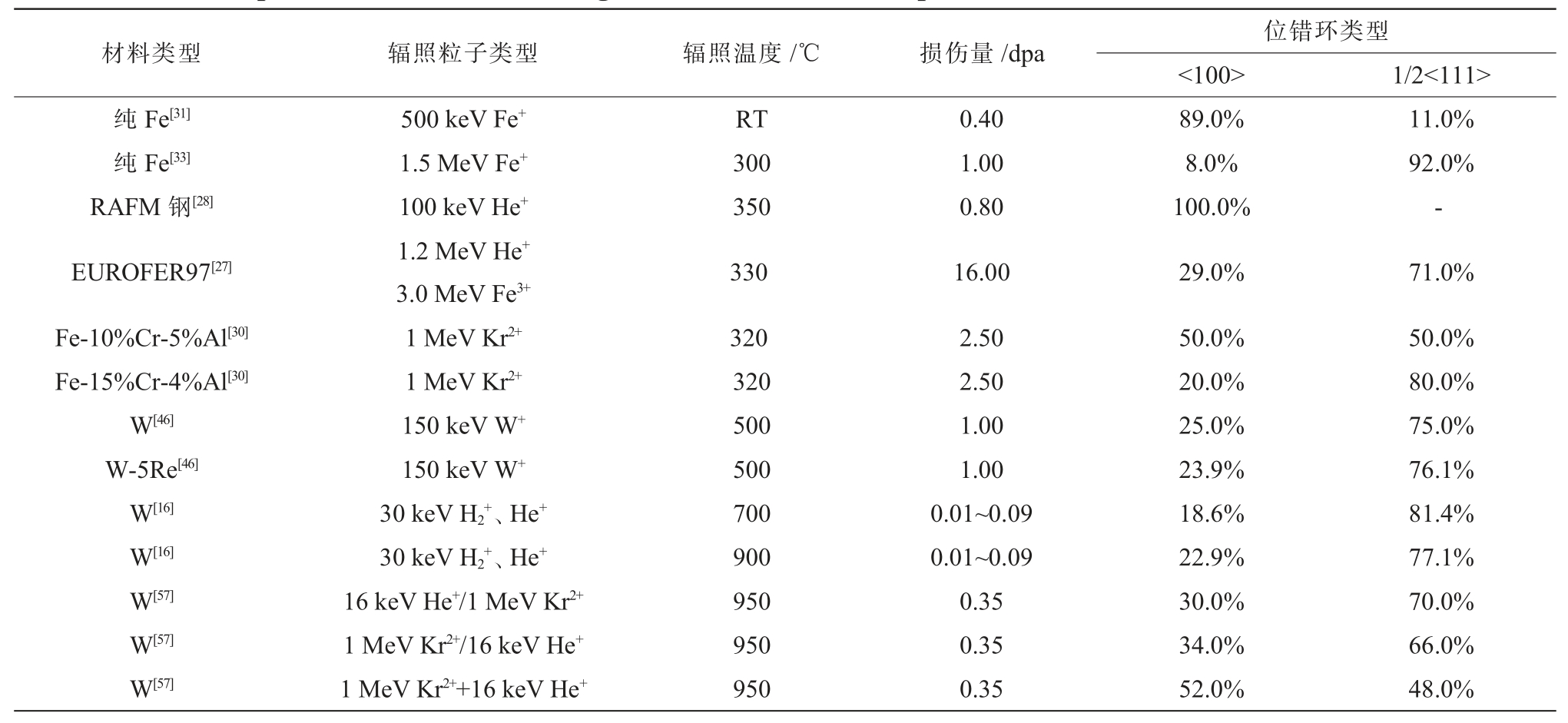
?
1.3 氦元素对位错环类型的影响
材料经中子轰击发生嬗变反应产生氦元素,氦是一种闭合电子壳层结构原子,几乎不溶于任何材料, 倾向与材料中已产生的空位结合形成氦泡,从而对空位型位错环的形成过程产生影响, 造成间隙型位错环比例增加[58]。 Harrison 等[47]在研究不同appm/dpa 损伤比对钨中位错环影响的过程中发现,随着appm/dpa 损伤比和温度的升高,间隙环的比例均有所提高,如图4~5 所示。 Zheng 等[26]在利用双束Fe+和He+辐照RAFM 钢时发现了相同的规律。 这是因为He 与空位的结合能很大, 一方面阻止间隙和空位复合;另一方面形成的氦空位团簇作为形核位点,可以帮助间隙位错环形核[12,59-61],而高温可以促进氦团簇的形成[12],进而影响间隙环的比例。 Ter entyev 等[56]利用分子动力学模拟证明了He 是通过与空位相互作用来提高间隙环的占比。 当氢元素存在时,它会促进氦团簇的形成,进而对位错环的类型产生影响。
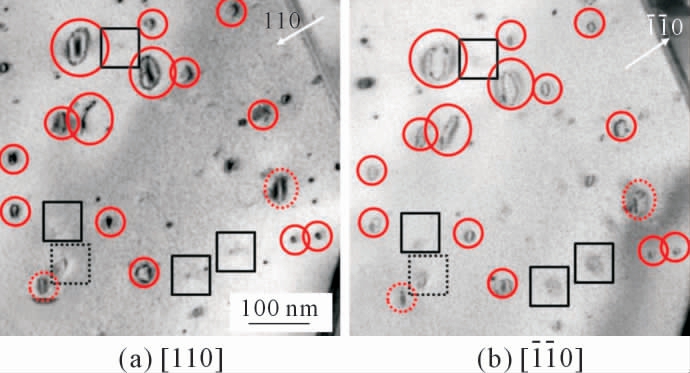
图4 <110>取向下15 keV He+在750 ℃辐照W 时的1/2<111>双束透射图[47](实心圆表示b=1/2[111]间隙环,虚线圆表示b=1/2[111]空位环,实方框表示b=1/2[ ]间隙环,虚线方框表示b=1/2[
]间隙环,虚线方框表示b=1/2[ ]空位环)
]空位环)
Fig.4 Double-beam transmission diagram of 15 keV He+irradiated W at 750 ℃under<110>orientation[47](Solid circles indicate interstitial loops with b=1/2[111],dashed circles indicate vacancy-type loops with b=1/2[111],solid squares indicate loops with b=1/2[ ] and dashed squares indicate vacancy loops with b=1/2[
] and dashed squares indicate vacancy loops with b=1/2[ ])
])

图5 温度和损伤比对位错环类型的影响[47]
Fig.5 Effects of temperature and damage ratio on the properties of dislocation loops[47]
1.4 氢氦元素对位错环尺寸和密度的影响
氢氦元素的引入不仅对位错环的类型和柏氏矢量产生影响,对位错环的尺寸和密度也有较大的影响。 在利用重离子模拟中子辐照时,随着损伤量的增加,位错环的尺寸和密度随之增加,在损伤量达到一定值时,达到饱和[2,62]。随着辐照温度的升高,位错环的尺寸增加,密度减小(图6),这是因为随着温度的升高,环的迁移率升高,环与环的合并造成位错环的尺寸增加而密度减小[10]。 另外温度的增加也会促进间隙和空位原子的复合,减少位错环形核。
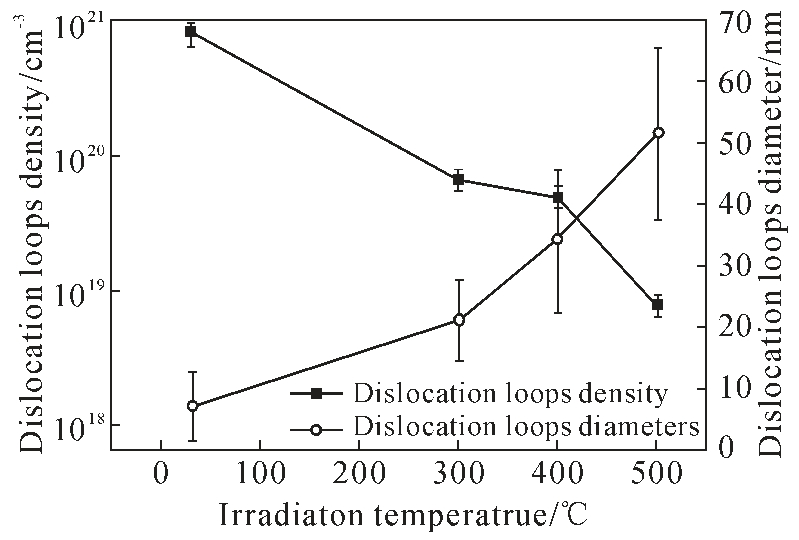
图6 单束30 keV He+辐照Ni 基合金位错环随温度变化折线
图[12]
Fig.6 A single beam of 30 keV He+irradiated Ni base alloy dislocation loop with temperature curve[12]
当利用单束He+辐照时,例如Luo 等[28]在研究RAFM 钢时, 利用透射电镜观察到尺寸高达到440 nm 的位错环,比相同损伤量下的中子、质子、重离子等辐照下的位错环都要大。 Zhang 等[25]利用10 keV H+, 18 keV He+ and 160 keV Ar+ 组合辐照RAFM 钢时发现,He+下的位错环尺寸环在3 种单束辐照下达到最大,如图7(b)所示。并且在相近损伤量条件下,单束Ar+辐照下并没有出现位错环,说明在相同辐照条件下,H、He 与空位的结合阻止了空位和间隙原子的复合,引起材料产生更大损伤[19]。当在双束辐照下,H+/He+ 中H 的存在促进位错环形核,以及He 注入后更容易被H-V 团簇捕获,不会对产生的间隙和空位复合过程产生影响, 进而使得位错环尺寸减小,密度增加(图8)。当改变注入顺序时,在He+/H+辐照条件下位错环达到最大,后注入H 与Hem-Vn 结合,形成H-Hem-Vn,使得产生的空位和间隙原子更多参与到位错环的长大,说明后注入的H+可以进一步促进位错环尺寸增加。 不同辐照条件下位错环尺寸统计,见图9,这与Yang 等[26]在研究RAFM钢中的氢氦协同作用时发现的规律一致。

图7 RAFM 钢经不同单束离子辐照后的透射显微图[25]
Fig.7 Transmission micrographs of RAFM steel irradiated by different single beam ions[25]
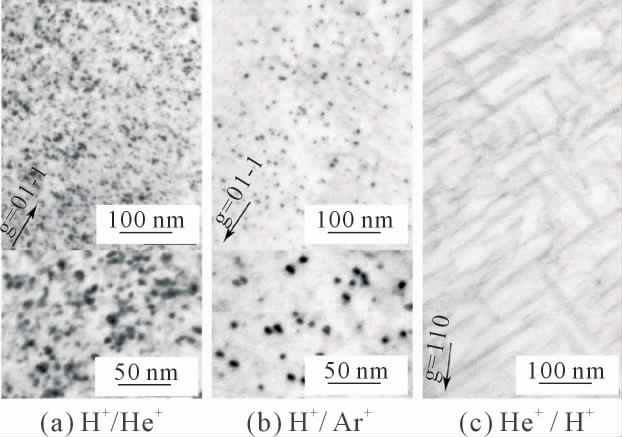
图8 RAFM 钢经不同双束离子辐照后的透射显微图[25]
Fig.8 Transmission micrograph of RAFM steel irradiated by different double beam ions[25]

图9 RAFM 钢不同辐照条件下位错环尺寸分布图[25]
Fig.9 Dislocation loop size distribution of RAFM steel under different irradiation conditions[25]
2 氢氦元素对空腔的影响
2.1 空腔的形成与分类
在材料服役过程中, 不同反应堆环境对材料的损伤程度不同,聚变堆中,材料一年所受到的损伤可高达150 dpa。 在一般的裂变堆中,材料的损伤值为20 dpa/ 年,但随着对能源需求的逐步提高,第四代裂变堆也在研发中, 其中服役的部件所受到的损伤高达30~200 dpa。在不同损伤水平下,产生的缺陷类型也有所不同[63]。当中子或离子辐照材料时,高能粒子引发高密度的级联碰撞,产生大量点缺陷。在相同温度下,由于空位迁移能是间隙原子迁移能的几十倍,因此更多的间隙原子快速迁移到晶界、界面等缺陷汇处[64],空位则聚集坍塌形成二维缺陷——空位环。 当空位聚集形成三维缺陷时, 就形成了空洞(voids)。通常空洞的形成需要较高的空位浓度,在损伤量较大时更易形成,并且其形成也与辐照温度相关,不同材料所需的最低形成温度不同[63]。由于核能生产过程中中子轰击材料引发嬗变生成氢氦元素,在辐照损伤的基础上引入了氢氦元素的作用, 实验中通常采用氢氦离子辐照进行研究, 在产生辐照损伤的同时引入两种元素,从而研究它们在辐照过程中的影响。
由于氦在材料中易于扩散、聚集、沉淀,当氦原子进入间隙后, 很容易被空位捕捉形成Hem-Vn 团簇, 当氦原子数量达到一定值时, 就会出现氦泡(bubbles)[29]。 由于两个氢原子的结合能比较低,不易形成氢泡,只有在一些特殊情况下会形成。 一般将气泡(bubbles)和空洞(voids)统称为空腔(cavities)。由于内部压强不同,气泡一般呈现球状,而空洞则一般呈现多面体状,如图10 所示。
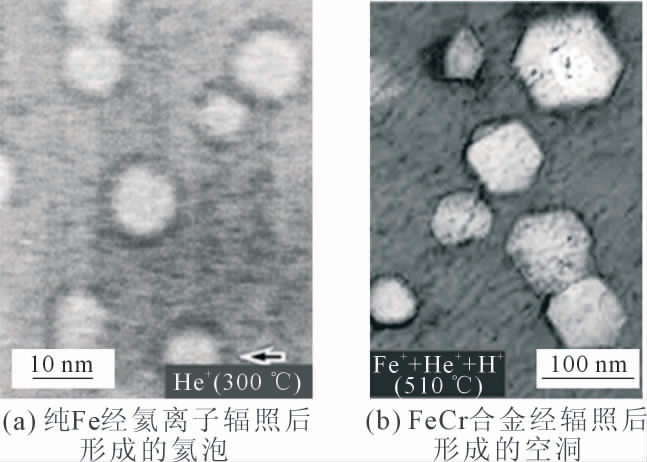
图10 纯Fe 经氦离子辐照后形成的氦泡及FeCr 合金经辐照后形成的空洞[38,65]
Fig.10 Helium bubbles of pure Fe irradiated by helium ions and cavities in irradiated FeCr alloy[38,65]
2.2 氢氦元素对空洞的影响
当材料经高能重离子轰击时, 在内部产生三维空洞,并随着损伤量增加,空洞尺寸增加;随辐照温度增加,空洞尺寸增加,密度减小[66-67](图11)。Li 等[37]在采用透射电镜研究重离子和氢氦离子3 束组合辐照下大块铬中微观结构的变化时发现,Fe2+ 和He2+共同注入时,He2+促进空洞形核, 空洞的密度提高;而Fe2+和H+共同注入时,空洞的尺寸增加,该条件下的空洞尺寸明显大于其余辐照条件下产生的空洞;Fe2+、He2+、H+3 束共同辐照时, 空洞的密度显著增加,说明其中氦起主要作用,通过图12 中的透射图可以直观清晰的观察到这种变化。 比较3 种辐照条件下的样品肿胀率发现,在Fe2++H+辐照条件下,材料的肿胀率达到最大, 说明空洞大小对于肿胀起到主要作用。 Tanaka 等[38]同样利用透射电镜观察重离子和氢氦离子不同组合辐照Fe-Cr 铁素体合金发现了和上述相同的规律,说明在铁基合金中氢氦对空洞的作用具有一致性,在奥氏体不锈钢(图23(a~b))[68]、FeCrNi 合金[69]等中均可体现。
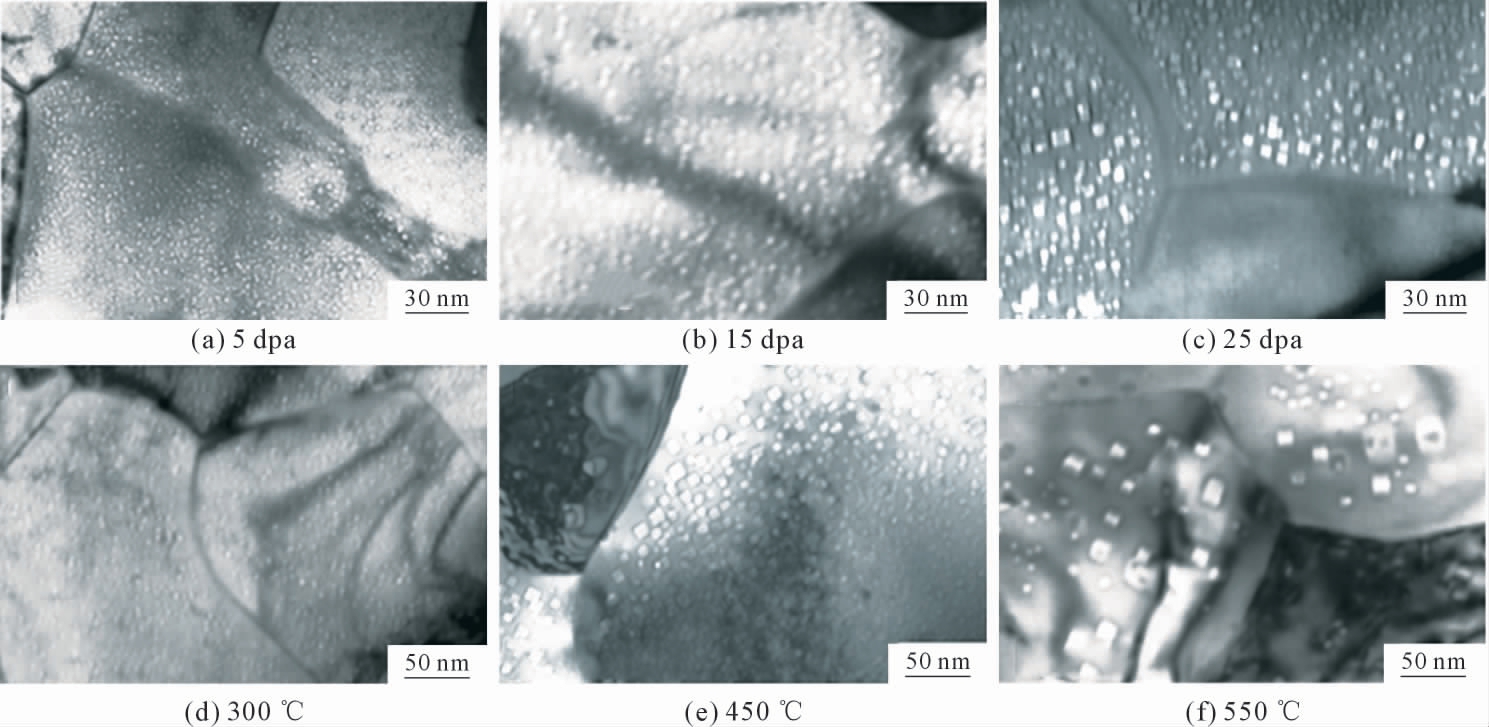
图11 锆合金在不同Ar+辐照条件下的空洞显微图[66-67]
Fig.11 Cavity micrograph of zirconium alloy under different Ar+irradiation conditions[66-67]

图12 铬在不同辐照条件下形成的空腔缺陷显微图[37]
Fig.12 Cavity defects formed in Cr under different irradiation conditions[37]
另外,Monterrosa 等[70]在研究T91 钢中氦对空洞的影响时发现,在高损伤条件下(150~300 dpa),氦浓度的高低对空洞分布和密度尺寸等没有显著的影响,而在损伤量相对较低的情况下,氦浓度的高低会影响空洞形核半径,在高氦浓度时,因为氦不溶于晶格,促进空洞缺陷的形成,并随着辐照温度的增加,空洞的尺寸增加,密度减小。
最新研究表明,氢的存在会促进空洞的迁移,这与传统观念氢对空位迁移具有抑制作用是相反的,Arakawa 等[71]通过对比高能电子辐照下无氢的空洞和有氢的空洞的行为, 研究了加热条件下氢对纳米级空腔行为的影响,将实验和模拟结合发现,氢可以诱导空洞多面体中面的消除来促进空洞迁移, 进而对材料的结构产生影响。
2.3 氢元素对氦泡的影响
材料在辐照损伤基础上引入氦元素, 产生了新的缺陷——氦泡。厦门大学Ding 等[16]利用原位辐照实验研究了在1 173 K 时,利用30 keV H2+、He+同时辐照W, 利用透镜观察到随注入的氢氦浓度和剂量率的增加,氦泡出现了一系列行为,包括新氦泡的形核,旧氦泡的湮没, 单个氦泡的长大以及两个氦泡的合并长大等过程,具体如图13 所示,因为辐照的温度较高,因此氦泡长大的现象较明显, 氦泡的生长机制包括扩散-融合机制和奥斯瓦尔德熟化理论两种[72]。

图13 1 173 K 下,30 keV H2+和He+双束照射W 中气泡的原位演化透射图像[16]
Fig.13 Transmission image of in situ evolution of bubbles in W under 30 keVH2+and He+double beam irradiation at 1 173 K[16]
嬗变反应生成氦元素的同时也会生成氢元素,氢元素的存在会对氦泡产生影响。 由于氢元素质量很小,进入晶格后易发生扩散,当已形成的Hem-Vn团簇吸收氢原子,造成氦泡的进一步长大。通过改变辐照顺序研究氢对氦泡的作用机制,包括预注入氢、同时注入及后注入氢。
Luo 等[73-74]在利用单束和双束的H+和He+辐照钨时利用透射电镜观察氦泡, 分析了氢对氦泡的尺寸和密度的影响,尺寸的具体变化如图14 所示。 在氦离子辐照后注入氢离子,随着氢剂量增加,氦泡的尺寸增加,说明氦气泡可能作为氢原子的捕获点,使得氦气泡周围氢浓度增加,在气泡内部复合形成H2分子,促使氦泡长大[75]。 但若改变氢氦注入顺序,在氦离子辐照前注入氢离子, 与单束的氦离子辐照相比,尺寸变化不大,但密度显著增加,如图14(f)所示,说明H+预先注入,形成的H-V 团簇促进了氦气泡的成核。 这是因为注入的H+初步引入了空位和H-V 团簇,H-V 团簇不稳定,易分解,在He+注入时提供了更多的空位,因此形核增加[75]。 通过对比图14(e)和(f)发现,在相同的剂量下,改变注入顺序,其密度和尺寸相差较大,说明辐照顺序不同,氢的作用机制也不同,不同条件下氦泡尺寸分布统计如图15所示。

图14 不同辐照条件下的氦泡显微图[73]
Fig.14 Micrograph of helium bubbles under different irradiation conditions[73]
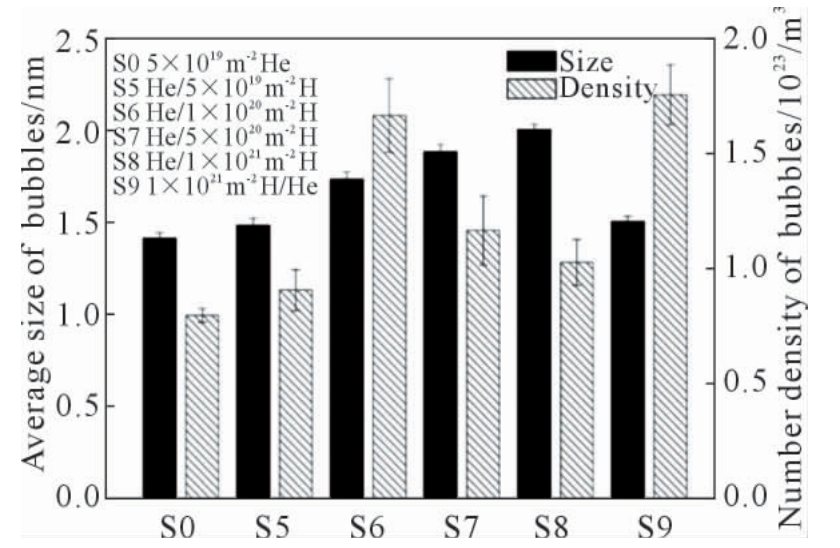
图15 不同辐照条件下的氦泡密度和尺寸统计图[73]
Fig.15 Statistical graph of helium bubble density and size under different irradiation conditions[73]
3 材料固有缺陷对氢氦行为影响
自由表面、晶界、相界等位置原子排列不规则,能量高,对晶体中产生的缺陷具有强吸引力,因此对材料中的氢氦元素和缺陷分布都有较大的影响。
3.1 晶界对氢氦行为的影响
EI-Atwani 等[51,57,76-77]在研究氦离子辐照对W性能影响时发现, 在He 注入区位错线和晶界处观察到位错环剥离区(图16(a)),大概十几个纳米宽,并发现在晶界处分布着较少的大尺寸氦泡(图16(b)),详细讨论了晶界[76]和晶粒尺寸[77]对氦泡分布的影响,这与Fan 等[78]研究添加不同合金元素的镍基合金中发现氦泡优先集中在晶界形成的机理相同。 因为自间隙原子的生成能显著高于空位,更倾向于被位错、晶界等吸收,以使系统能量降低[79],空位在晶界处聚集使得形成的氦泡尺寸远大于晶内,密度相对更低。Kuprin 等[66]在研究锆合金的辐照性能时,也发现了晶界附近的空洞剥离区(图16(c))。

图16 晶界剥离区位错环[80],氦泡[80],空洞[66]
Fig.16 Dislocation loop[80],helium bubble[80]and cavity[66]in grain boundary striping zone
3.2 表面和界面对氢氦行为的影响
Li 等[18]在钨的原位辐照过程中,观察到表面剥离区(图17(a)),即表面效应[80-81],这也是利用原位和非原位观察缺陷的差异所在[19,48]。Li 等[18]利用分子动力学(MD)模拟了1/2<111> 位错环从形核到最终湮没在表面的过程, 从原子层面解释了表面效应出现的原因。 Huang 等[82]在改进镀铬锆合金的辐照性能研究过程中,利用原位He+辐照后,观察到氦气泡优先沿着Cr 晶界汇聚形成,当气泡进一步长大,就会造成沿晶界形成微裂纹, 对材料的性能产生影响。由于中间Ni 层的添加,改变界面结构,增加界面结合力, 并且发现由于Ni 和Cr 处于共格界面而没有缺陷聚集, 过渡层Ni 与Zr 产生冶金结合生成很多层第二相,层与层之间的界面吸收了更多的缺陷,形成高密度的氦泡,如图19 所示。 Zhang 等[80]在Fe3+和He+辐照W 时却发现了界面损伤剥离区。这与材料具体所受辐照参数相关,当氦浓度较高时,界面吸收缺陷有限, 高氦浓度则有利于在界面形成高密度氦泡,而当氦浓度较低时,界面吸收大量缺陷而形成剥离区或者大尺寸氦泡。 另外, 在早期的研究中,当低能He+的辐照剂量高达1018 ions/cm2 时,表面作为一种强缺陷汇促进He 向表面扩散, 当浓度达到一定值时,就会产生表面起泡现象,如图17(b)所示[83]。 因为实际反应堆内的氦浓度不及实验浓度,这种损伤现象在实际中也较少出现。
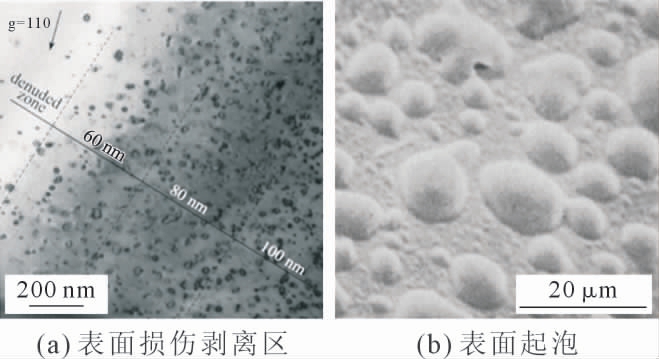
图17 表面损伤剥离区和表面起泡[18,83]
Fig.17 Surface damage stripping area and surface blistering [18,83]

图18 表面效应下的位错环变化[18]
Fig.18 Dislocation loop changes under surface effects[18]
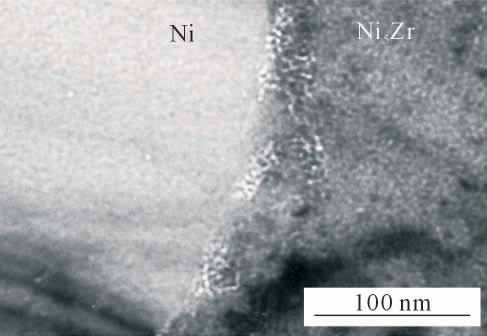
图19 界面处分布的高密度氦泡[82]
Fig.19 Highdensity helium bubbles at the interface[82]
4 氢氦对辐照损伤的协同效应
氢氦元素的引入对材料内部的结构有很大的影响,而结构的变化必然会引起材料性能的变化,例如辐照硬化脆化、辐照肿胀,辐照蠕变以及韧脆转变温度(DBTT)升高等。 氢氦元素的存在对材料硬化脆化和肿胀性能影响最大,并在氢氦共存时损伤达到最大。
4.1 辐照硬化脆化
硬化的本质是材料内部位错运动受阻, 当材料受辐照后, 内部产生的位错环和氦泡也可以作为位错运动的障碍物,造成材料硬化脆化。 经研究发现,BCC 结构材料经辐照后硬化程度要比FCC 结构和HCP 结构材料高出几倍。
Ding 等[21]在利用30 keV He+辐照纯Mo 时,材料内部因位错环产生而发生硬化。 在辐照W[16]时同样发生了硬化,并采用DBH 模型和FKH 模型计算了位错环和氦泡对硬化的贡献量。 其中,DBH 模型适合于较强障碍物(位错环),而FKH 模型则更适用于较弱的障碍物(氦泡),在图20 中呈现了随着损伤量增加,位错环和氦泡对材料硬化程度的贡献,位错环引起材料硬化的程度更大。Arsenlis 等[84]在利用位错环动力学模拟(DD) 研究时也发现,随着位错环密度增加,材料的屈服强度增加,如图21 所示。 而在Ni 基合金中,通过对重离子和氦离子以及双束共同辐照时的硬度比较(图22),发现重离子产生更多位错环引起比氦离子更强的硬化, 在双束辐照条件下硬度达到最大。
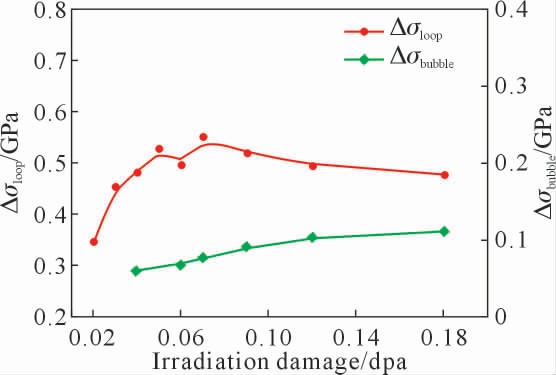
图20 氦泡、位错环强化程度与损伤关系[16]
Fig.20 The relationship ofhelium bubble and dislocation loop strengthening
and dislocation loop strengthening with irradiation damage[16]
with irradiation damage[16]
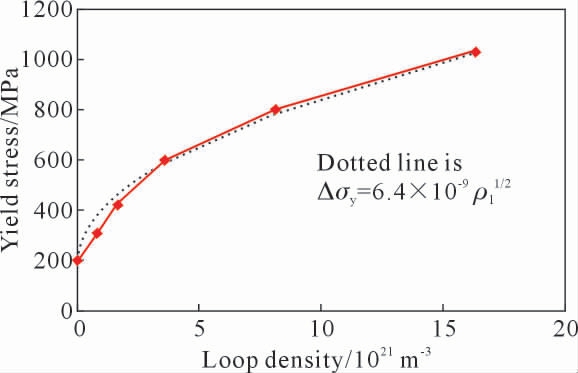
图21 位错环与屈服强度关系模拟研究[84]
Fig.21 Simulation of the relationship between dislocation loops and yield strength[84]
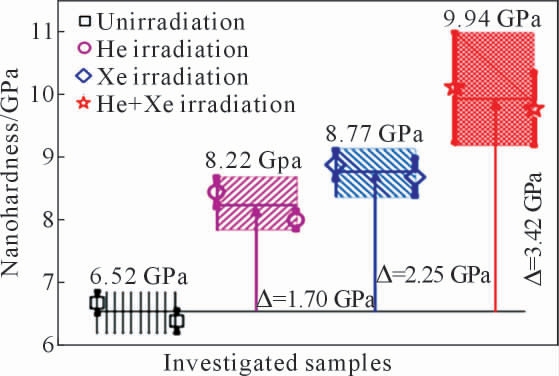
图22 镍在不同辐照条件下的硬化程度[86]
Fig.22 Degree of hardening of nickel under different irradiation conditions[86]
最新研究发现,在体心立方金属中,除了辐照形成的位错环、氦泡等引起硬化之外,还存在一种新的硬化机制—不可见点缺陷复合体-“暗物质”-硬化。Zheng 等[85]在利用He+ 高温辐照钨时发现,基于氦泡等可见缺陷的强化只占实验测得强化值的30%,利用氦原子追踪技术, 发现可见氦泡中的氦只占注入总氦量的很小比例, 超过80%以上的氦仍隐藏在晶格中,形成高密度Hem-Vn 团簇,阻碍位错运动。这说明空位与氦空位团簇等不可见点缺陷复合体与位错间也存在强烈相互作用,最终造成钨的高度辐照硬化。
4.2 辐照肿胀
氢氦元素的引入影响材料内部缺陷, 氦元素不仅可以与空位结合形成新的缺陷-氦泡, 还可以促进空洞的形核。当氢氦共同存在时,氢元素会促进氦泡和空洞长大,造成材料体积变化,引起辐照肿胀。
Borodin 等[68]在利用不同组合离子束辐照奥氏体不锈钢时,发现随着温度的升高,氢氦的引入对肿胀率的影响很大。氢会促进空洞长大,氦会促进空洞形核, 提高空洞密度, 从图23 曲线上分析得到,在600 ℃,Cr3+和 双束辐照达到了肿胀率最大,说明空洞尺寸相对空洞密度对肿胀的影响更大。 Tanaka等[38]在研究铁素体钢时也发现了相同的规律。Wakai等[87]利用离子束模拟不同工况条件下材料的肿胀行为时发现, 当辐照温度为470 ℃, 损伤量达50 dpa时,在散裂靶容器工况模拟下,由于氦元素浓度高,促进空腔形核、 造成其尺寸相对于聚变堆工况下较小, 引起的肿胀程度也相对较低。 而在聚变堆工况下,三束辐照下的空腔尺寸明显大于双束条件,因为氢元素的引入促进空洞和氦泡长大(图24(b)),而大尺寸空腔是造成材料肿胀的关键原因。 因而在利用三束离子辐照模拟聚变堆工况时,肿胀率达到最大。
双束辐照达到了肿胀率最大,说明空洞尺寸相对空洞密度对肿胀的影响更大。 Tanaka等[38]在研究铁素体钢时也发现了相同的规律。Wakai等[87]利用离子束模拟不同工况条件下材料的肿胀行为时发现, 当辐照温度为470 ℃, 损伤量达50 dpa时,在散裂靶容器工况模拟下,由于氦元素浓度高,促进空腔形核、 造成其尺寸相对于聚变堆工况下较小, 引起的肿胀程度也相对较低。 而在聚变堆工况下,三束辐照下的空腔尺寸明显大于双束条件,因为氢元素的引入促进空洞和氦泡长大(图24(b)),而大尺寸空腔是造成材料肿胀的关键原因。 因而在利用三束离子辐照模拟聚变堆工况时,肿胀率达到最大。

图23 在不同组合辐照条件下空洞随温度变化[68]
Fig.23 Swelling rate under different combinations of irradiation[68]
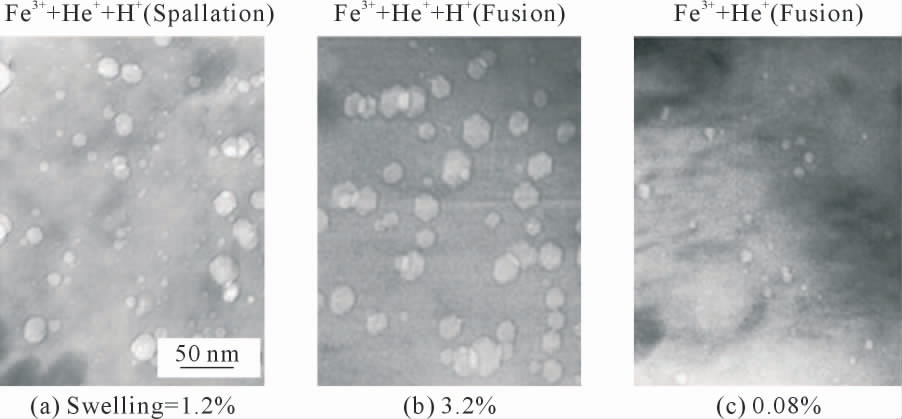
图24 不同辐照条件下F82H 钢的肿胀行为[87]
Fig.24 Swelling behavior of F82H steel under different irradiation conditions[87]
5 结语
核金属结构材料在辐照过程中的氢氦行为可以归纳为以下3 点:
(1)氦元素的引入,不仅会产生大尺寸位错环,促进空洞形核,还会引入新的缺陷-氦泡;另外,氦泡可以促进间隙位错环和<100>位错环和1/2<110>位错环形成,对位错环存在的形式产生影响。
(2)氢元素相对来说会对原有缺陷的尺寸产生较大的影响,无论是位错环、氦泡还是空洞,氢元素的引入均会促进其尺寸增加。
(3)当氢氦元素共同存在时,氢注入顺序不同,产生的影响不同,预先注入的氢具有稳定氦团簇,促进氦团簇形核的作用,从而提高其密度,而后注入的氢则更多促进氦团簇的长大。 两者之间的协同作用以及与位移损伤的协同作用,使材料损伤加重。
[1] 田慧芳.全球核能发展的现状与趋势[J]. 世界知识,2022,4:48-50.
[2] YU H, YAO Z, IDREES Y, et al. Accumulation of dislocation loops in the α phase of Zr-excel alloy under heavy ion irradiation[J].Journal of Nuclear Materials,2017,491:232-241.
[3] MAIER B R,YEOM H,JOHNSON G,et al.In situ TEM investigation of irradiation-induced defect formation in cold spray Cr coatings for accident tolerant fuel applications[J].Journal of Nuclear Materials,2018,512:320-323.
[4] IDREES Y,YAO Z,KIRK M A,et al.In situ study of defect accumulation in zirconium under heavy ion irradiation[J]. Journal of Nuclear Materials,2013,433(1-3):95-107.
[5] IDREES Y,FRANCIS E M,YAO Z,et al.Effects of alloying elements on the formation of
[6] HARTE A,JA¨DERNA¨S D,TOPPING M,et al.The effect of matrix chemistry on dislocation evolution in an irradiated Zr alloy[J].Acta Materialia,2017,130:69-82.
[7] FRANCIS E,BABU R P,HARTE A,et al.Effect of Nb and Fe on damage evolution in a Zr-alloy during proton and neutron irradiation[J].Acta Materialia,2019,165:603-614.
[8] GAUMÉM,BALDO P,MOMPIOU F,et al.In-situ observation of an irradiation creep deformation mechanism in zirconium alloys[J].Scripta Materialia,2018,154:87-91.
[9] TOPPING M, HARTE A, UNGÁR T, et al. The effect of irradiation temperature on damage structures in proton-irradiated zirconium alloys[J].Journal of Nuclear Materials,2019,514:358-367.
[10] JIN H H, KO E, LIM S, et al. Effect of irradiation temperature on microstructural changes in self-ion irradiated austenitic stainless steel[J].Journal of Nuclear Materials,2017,493:239-245.
[11] WAS G S, ALLEN T R, BUSBY J T, et al. Microchemistry and microstructure of proton-irradiated austenitic alloys:toward an understanding of irradiation effects in LWR core components[J].Journal of Nuclear Materials,1999,270:96-114.
[12] CHEN H C, LUI R D, REN C L, et al. Evolution of dislocation loops in He ion irradiated nickel under different temperature[J].Journal of Applied Physics,2016,120(12):125303.
[13] YAN Z, LIU S, XIA S, et al. He behavior in Ni and Ni-based equiatomic solid solution alloy[J].Journal of Nuclear Materials,2018,505:200-206.
[14] NIWASE K,EZAWA T,TANABE T,et al.Dislocation loops and their depth profiles in He+and D+ion irradiated nickel [J].Journal of Nuclear Materials,1993,203:56-66.
[15] ONO K, ARAKAWA K, YOSHIDA N. Dynamical process of defect clustering in Ni under the irradiation with low energy helium ions[J].Journal of Nuclear Materials,1999,271:214-219.
[16] DING Y, LI Y, LIU X, et al. In-situ transmission electron microscopy observation of the evolution of dislocation loops and gas bubbles in tungsten during H2+ and He+ dual-beam irradiation[J].Tungsten,2021,3(4):434-447.
[17] YI X,JENKINS M L,HATTAR K,et al.Characterisation of radiation damage in W and W-based alloys from 2 MeV self-ion near-bulk implantations[J].Acta Materialia,2015,92:163-177.
[18] LI Y,WANG L,RAN G,et al.In-situ TEM investigation of 30 keV He+ irradiated tungsten: Effects of temperature, fluence, and sample thickness on dislocation loop evolution[J]. Acta Materialia,2021,206:116618.
[19] ZHENG R,HAN W.Comparative study of radiation defects in ion irradiated bulk and thin-foil tungsten[J]. Acta Materialia, 2020,186:162-171.
[20] HARRISON R W, AMARI H, GREAVES G, et al. Effect of He-appm/DPA ratio on the damage microstructure of tungsten[J].MRS Advances,2016,1(2):141-146.
[21] LI Y,RAN G,GUO Y,et al.The evolution of dislocation loop and its interaction with pre-existing dislocation in He+-irradiated molybdenum: in-situ TEM observation and molecular dynamics simulation[J].Acta Materialia,2020,201:462-476.
[22] CHENG B, KIM Y-J, CHOU P. Improving accident tolerance of nuclear fuel with coated Mo-alloy cladding[J]. Nuclear Engineering and Technology,2016,48(1):16-25.
[23] COCKERAM B V,SMITH R W,LEONARD K J,et al.Irradiation hardening in unalloyed and ODS molybdenum during low dose neutron irradiation at 300 ℃and 600 ℃[J]. Journal of Nuclear Materials,2008,382(1):1-23.
[24] SEKIMURA N,IWAI T,ARAI Y, et al. Synergistic effects of hydrogen and helium on microstructural evolution in vanadium alloys by triple ion beam irradiation[J].Journal of Nuclear Materials,2000,283-287:224-228.
[25] ZHANG W,LUO F,YU Y,et al.Synergistic effects on dislocation loops in reduced-activation martensitic steel investigated by single and sequential hydrogen/helium ion irradiation[J].Journal of Nuclear Materials,2016,479:302-306.
[26] YANG Z,LUO F,ZHENG Z,et al.TEM observation of dislocation loops induced by single and sequential helium/hydrogen irradiations in reduced-activation martensitic steel[J].Fusion Engineering and Design,2017,125:349-353.
[27] KAISER B, GAGANIDZE E, DETHLOFF C, et al. Investigation of microstructure defects in EUROFER97 under He+/Fe3+dual ion beam irradiation[J].Nuclear Materials and Energy,2018,15:148-153.
[28] LUO F, YAO Z, GUO L, et al. Convoluted dislocation loops induced by helium irradiation in reduced-activation martensitic steel and their impact on mechanical properties[J]. Materials Science and Engineering:A,2014,607:390-396.
[29] CHEN Y,LI Y,RAN G,et al.In-situ TEM observation of the evolution of dislocation loops and helium bubbles in a pre helium irradiated FeCrAl alloy during annealing[J].Progress in Nuclear Energy,2020,129:103502.
[30] HALEY J C,BRIGGS S A,EDMONDSON P D,et al.Dislocation loop evolution during in-situ ion irradiation of model FeCrAl alloys[J].Acta Materialia,2017,136:390-401.
[31] PROKHODTSEVA A,DÉCAMPS B,RAMAR A,et al.Impact of He and Cr on defect accumulation in ion-irradiated ultrahigh-purity Fe(Cr)alloys[J].Acta Materialia,2013,61(18):6958-6971.
[32] KO¨GLER R,ANWAND W,RICHTER A,et al.Nanocavity formation and hardness increase by dual ion beam irradiation of oxide dispersion strengthened FeCrAl alloy[J].Journal of Nuclear Materials,2012,427(1-3):133-139.
[33] XU S,YAO Z,JENKINS M L.TEM characterisation of heavy-ion irradiation damage in FeCr alloys[J].Journal of Nuclear Materials,2009,386-388:161-164.
[34] BERGNER F, HLAWACEK G, HEINTZE C. Helium-ion microscopy, helium-ion irradiation and nanoindentation of Eurofer 97 and ODS Eurofer[J].Journal of Nuclear Materials,2018,505:267-275.
[35] ZHANG H, ZHANG C, YANG Y, et al. Irradiation hardening of ODS ferritic steels under helium implantation and heavy-ion irradiation[J].Journal of Nuclear Materials,2014,455(1-3):349-353.
[36] CHEN D, TONG Y, WANG J, et al. Microstructural response of He+ irradiated FeCoNiCrTi0.2 high-entropy alloy[J]. Journal of Nuclear Materials,2018,510:187-192.
[37] JIANG L,PENG Q,XIU P,et al.Elucidating He-H assisted cavity evolution in alpha Cr under multiple ion beam irradiation[J].Scripta Materialia,2020,187:291-295.
[38] TANAKA T,OKA K,OHNUKI S,et al.Synergistic effect of helium and hydrogen for defect evolution under multi-ion irradiation of Fe-Cr ferritic alloys[J]. Journal of Nuclear Materials,2004,329-333:294-298.
[39] COCKERAM B V, SMITH R W, HASHIMOTO N, et al. The swelling, microstructure, and hardening of wrought LCAC, TZM,and ODS molybdenum following neutron irradiation[J].Journal of Nuclear Materials,2011,418(1-3):121-136.
[40] 易晓鸥. 金属W 中辐照缺陷的产生、演化与热回复机制[J]. 金属学报,2021,57(3):257-271.
[41] DICKERSON C,YANG Y,ALLEN T R. Defects and microstructural evolution of proton irradiated titanium carbide[J].Journal of Nuclear Materials,2012,424(1-3):62-68.
[42] 郭立平,罗凤凤,于雁霞. 核材料辐照位错环[M]. 北京: 国防工业出版社,2017.
[43] IDREES Y,YAO Z,SATTARI M.Heavy ion irradiation effects in Zr excel alloy pressure tube material[C]//The 33rd Annual Conference,Canada:The Canadian Nclear Society,2012.
[44] LIU S M,BEYERLEIN I J,HAN W Z.Two-dimensional vacancy platelets as precursors for basal dislocation loops in hexagonal zirconium[J].Nature Communications,2020,11(1):5766.
[45] BRIMBAL D, D ÉCAMPS B, HENRY J, et al. Single- and dual-beam in situ irradiations of high-purity iron in a transmission electron microscope: Effects of heavy ion irradiation and helium injection[J].Acta Materialia,2014,64:391-401.
[46] YI X,JENKINS M L,BRICENO M,et al.In situ study of self-ion irradiation damage in W and W-5Re at 500 ℃[J].Philosophical Magazine,2013,93(14):1715-1738.
[47] HARRISON R W,GREAVES G,HINKS J A,et al.A study of the effect of helium concentration and displacement damage on the microstructure of helium ion irradiated tungsten[J].Journal of Nuclear Materials,2017,495:492-503.
[48] HARRISON R W,PENG N,WEBB R P,et al.Characterisation of helium ion irradiated bulk tungsten:A comparison with the in-situ TEM technique[J].Fusion Engineering andDesign,2019,138:210-216.
[49] EYRE B L,BULLOUGH R.On the formation of interstitial loops in b.c.c.metals[J].Philosophical Magazine,1965,12(115):31-39.
[50] YAO B, EDWARDS D J, KURTZ R J. TEM characterization of dislocation loops in irradiated bcc Fe-based steels[J]. Journal of Nuclear Materials,2013,434(1-3):402-410.
[51] EL-ATWANI O,ESQUIVEL E,EFE M,et al.Loop and void damage during heavy ion irradiation on nanocrystalline and coarse grained tungsten: Microstructure, effect of dpa rate, temperature and grain size[J].Acta Materialia,2018,149:206-219.
[52] DING Y, GUO L, LI Y, et al. In-situ TEM observation and MD simulation of the reaction and transformation of <100> loops in tungsten during H2+ & He+ dual-beam irradiation[J]. Scripta Materialia,2021,204:114154.
[53] SCHA¨ UBLIN R, DÉCAMPS B, PROKHODTSEVA A, et al. On the origin of primary 1/2a0<111>and a0<100>loops in irradiated Fe(Cr)alloys[J].Acta Materialia,2017,133:427-439.
[54] GRANBERG F,BYGGMA¨STAR J,SAND A E,et al.Cascade debris overlap mechanism of<100>dislocation loop formation in Fe and FeCr[J].Europhysics Letters,2017,119(5):56003.
[55] ARAKAWA K,AMINO T,MORI H.Direct observation of the coalescence process between nanoscale dislocation loops with different Burgers vectors[J].Acta Materialia,2011,59(1):141-145.
[56] TERENTYEV D,ANENTO N,SERRA A,et al.Interaction of He and He-V clusters with self-interstitials and dislocations defects in bcc Fe[J].Journal of Nuclear Materials,2015,458:11-21.
[57] EL-ATWANI O, CUNNINGHAM W S, TRELEWICZ J R, et al.Revealing the synergistic effects of sequential and simultaneous dual beam irradiations in tungsten via in-situ TEM[J].Journal of Nuclear Materials,2020,538:152150.
[58] YANG Q,FAN H,NI W,et al.Observation of interstitial loops in He+irradiated W by conductive atomic force microscopy[J].Acta Materialia,2015,92:178-188.
[59] WOLFER W G. Dislocation loop punching in bubble arrays[J].Philosophical Magazine A,1989,59(1):87-103.
[60] ARAKAWA K, MORI H, ONO K. Formation process of dislocation loops in iron under irradiations with low-energy helium, hydrogen ions or high-energy electrons[J].Journal of Nuclear Materials,2002 307-311:272-277.
[61] ARAKAWA K, IMAMURA R, OHOTA K, et al. Evolution of point defect clusters in pure iron under low-energy He+irradiation[J].Journal of Applied Physics,2001,89(9):4752-4757.
[62] LU C, LU Z, XIE R, et al. Microstructure of a 14Cr-ODS ferritic steel before and after helium ion implantation[J].Journal of Nuclear Materials,2014,455(1-3):366-370.
[63] ZHANG X, HATTAR K, CHEN Y, et al. Radiation damage in nanostructured materials[J]. Progress in Materials Science, 2018,96:217-321.
[64] BALLUFFI R W. Vacancy defect mobilities and binding-energies obtained from annealing studies[J]. Journal of Nuclear Materials,1978,69-7(1-2):240-263.
[65] ONO K, ARAKAWA K, HOJOU K. Formation and migration of helium bubbles in Fe and Fe-9Cr ferritic alloy[J].Journal of Nuclear Materials,2002,307-311:1507-1512.
[66] KUPRIN A S,BELOUS V A,VOYEVODIN V N,et al.Irradiation resistance of vacuum arc chromium coatings for zirconium alloy fuel claddings[J].Journalof Nuclear Materials,2018,510:163-167.
[67] KUPRIN A S, VASILENKO R L, TOLSTOLUTSKAYA G D, et al. Irradiation resistance of chromium coatings for ATFC in the temperature range 300~550 ℃[J].Journal of Nuclear Materials,2021,549:152908.
[68] BORODIN O V,BRYK V V,KALCHENKO A S,et al.Synergistic effects of helium and hydrogen on self-ion-induced swelling of austenitic 18Cr10NiTi stainless steel[J].Journal of Nuclear Materials,2013,442(1-3):S817-S820.
[69] MURASE Y, NAGAKAWA J, YAMAMOTO N, et al. Void swelling in Fe-15Cr-xNi ternary alloys under proton irradiation[J].Journal of Nuclear Materials,1998,255(1):34-43.
[70] MONTERROSA A M,JIAO Z,WAS G S.The influence of helium on cavity evolution in ion-irradiated T91[J]. Journal of Nuclear Materials,2018,509:707-721.
[71] ARAKAWA K,KAGEYAMA A,HIROSHIMA H,et al.Hydrogen effects on the migration of nanoscale cavities in iron[J]. ISIJ International,2021,61(8):2305-2307.
[72] CHERNIKOV V N, TRINKAUS H, ULLMAIER H. Helium bubbles in nickel annealed at T>0.7 T(m)[J].Journal of Nuclear Materials,1997,250(2-3):103-110.
[73] LUO F,GUO L,LU D,et al.TEM observation of bubbles induced by single and sequential He/H irradiation in tungsten[J]. Fusion Engineering and Design,2017,125:463-467.
[74] LUO F,WANG J,ZHANG L,et al.Effect of hydrogen pre-implantation on formation and growth of bubbles in tungsten under helium ion irradiation[J].Nuclear Instruments and Methods in Physics Research Section B:Beam Interactions with Materials and Atoms,2019,450:224-228.
[75] SHEN Z,ZHENG Z,LUO F,et al.Effects of sequential helium and hydrogen ion irradiation on the nucleation and evolution of bubbles in tungsten[J]. Fusion Engineering and Design, 2017, 115:80-84.
[76] EL-ATWANI O,CUNNINGHAM W S,PEREZ D,et al.Temperature threshold for preferential bubble formation on grain boundaries in tungsten under in-situ helium irradiation[J]. Scripta Materialia,2020,180:6-10.
[77] EL-ATWANI O, NATHANIEL J E, LEFF A C, et al. The role of grain size in He bubble formation: Implications for swelling resistance[J].Journal of Nuclear Materials,2017,484:236-244.
[78] FAN Z,ZHAO S,JIN K,et al.Helium irradiated cavity formation and defect energetics in Ni-based binary single-phase concentrated solid solution alloys[J].Acta Materialia,2019,164:283-292.
[79] 薛飞王,刘向兵,赖文生,等. 核电材料辐照损伤的多尺度高通量计算模拟[J].装备环境工程,2022,19(1):1-10.
[80] ZHANG Z, YABUUCHI K, KIMURA A. Defect distribution in ion-irradiated pure tungsten at different temperatures[J].Journal of Nuclear Materials,2016,480:207-215.
[81] BARASHEV A V, XU H, STOLLER R E. The behavior of small helium clusters near free surfaces in tungsten[J].Journal of Nuclear Materials,2014,454(1-3):421-426.
[82] HUANG M,LI Y,RAN G,et al.Cr-coated Zr-4 alloy prepared by electroplating and its in situ He+irradiation behavior[J].Journal of Nuclear Materials,2020,538:152240.
[83] ZEE R H,WATTERS J F.Effects of cold work and niobium on the blistering of zirconium by helium atoms[J]. Journal of Nuclear Materials,1984,122:1491-1496.
[84] ARSENLIS A,RHEE M,HOMMES G,et al.A dislocation dynamics study of the transition from homogeneous to heterogeneous deformation in irradiated body-centered cubic iron[J].Acta Materialia,2012,60(9):3748-3757.
[85] ZHENG R Y,JIAN W R,BEYERLEIN I J,et al.Atomic-scale hidden point-defect complexes induce ultrahigh-irradiation hardening in tungsten[J].Nano Letters,2021,21(13):5798-5804.
[86] GAO J,HUANG H,LIU J,et al.Synergistic effects on microstructural evolution and hardening of the Hastelloy N alloy under subsequent He and Xe ion irradiation[J]. Journal of Applied Physics,2018,123(20):205901.
[87] WAKAI E,KIKUCHI K,YAMAMOTO S,et al.Swelling behavior of F82H steel irradiated by triple/dual ion beams[J].Journal of Nuclear Materials,2003,318:267-273.